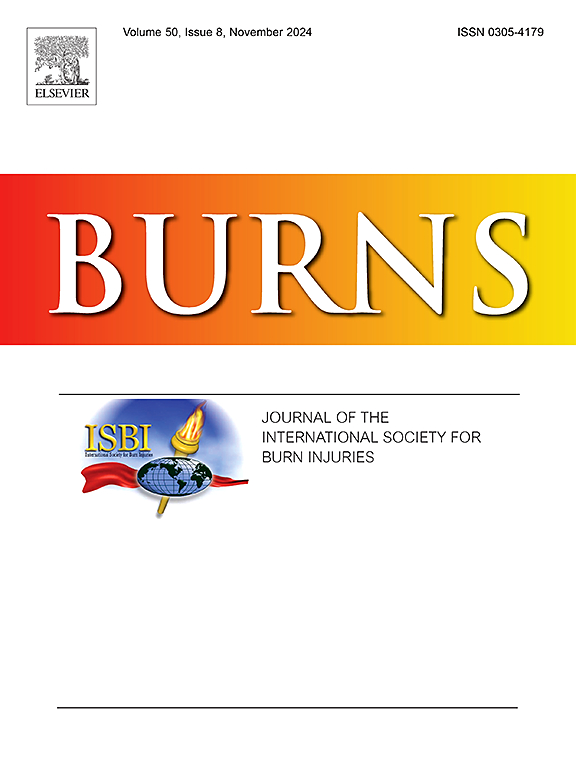Geospatial analysis of community-level social and environmental barriers for adult burn injury survivors in North Texas
IF 3.2
3区 医学
Q2 CRITICAL CARE MEDICINE
引用次数: 0
Abstract
Purpose
This study investigates geographic variations in community integration among burn injury survivors in North Texas and identifies community-level social and environmental factors that influence their post-injury community reintegration.
Methods
We utilized data from the Burn Model System (BMS) National Database, focusing on 153 adult burn injury survivors in North Texas who sustained injuries between 2015 and 2022. We conducted county-level mapping to visualize temporal changes in Community Integration Questionnaire (CIQ) scores by comparing pre-injury scores to post-injury scores at 6 and 12 months. Next, we categorized counties into two groups: (1) counties with consistent declines in CIQ scores over the 12-month post-injury period, and (2) all other counties with burn injury survivors. We then compared county-level community characteristics between these two groups, focusing on four factors: socioeconomic conditions, access to healthcare, public safety, and the built environment.
Results
There were geographic disparities in CIQ score changes among counties after burn injury. Counties with consistent decreases in CIQ scores had significantly higher levels of poverty, higher unemployment rates, increased crime rates, and lower access to healthy food options compared to other counties.
Conclusions
The findings suggest that rural counties may lack a supportive environment for burn injury survivors, highlighting the need for targeted interventions to promote community integration. Implementing strategies to reduce socioeconomic disparities, enhance public safety, and improve access to nutritious food could help facilitate better community reintegration outcomes for burn injury survivors. Furthermore, clinicians can leverage these insights by offering patient-level supports—such as localized telehealth services, peer support group referrals at discharge, and guidance on local resources—to help individuals navigate environmental barriers and maintain community engagement after returning home.
北德克萨斯州成人烧伤幸存者社区层面社会和环境障碍的地理空间分析
目的:本研究调查了北德克萨斯州烧伤幸存者社区融入的地理差异,并确定了影响他们伤后社区融入的社区层面的社会和环境因素。方法:我们利用烧伤模型系统(BMS)国家数据库的数据,重点研究2015年至2022年期间北德克萨斯州153名成人烧伤幸存者。我们通过比较受伤前和受伤后6个月和12个月的得分,在县级范围内绘制社区融合问卷(CIQ)得分的时间变化图。接下来,我们将县分为两组:(1)在受伤后12个月内CIQ分数持续下降的县,以及(2)所有其他有烧伤幸存者的县。然后,我们比较了这两组之间的县级社区特征,重点关注四个因素:社会经济条件、医疗保健、公共安全和建筑环境。结果各区县烧伤后CIQ评分变化存在地域差异。与其他县相比,CIQ得分持续下降的县的贫困水平、失业率、犯罪率明显更高,获得健康食品的机会也更少。结论农村县可能缺乏对烧伤幸存者的支持性环境,强调需要有针对性的干预措施来促进社区融合。实施减少社会经济差距、加强公共安全和改善营养食品获取的战略,有助于促进烧伤幸存者更好地融入社区。此外,临床医生可以通过提供患者层面的支持来利用这些见解,例如本地化的远程医疗服务,出院时的同伴支持小组转诊,以及对当地资源的指导,帮助个人克服环境障碍,并在回家后保持社区参与。
本文章由计算机程序翻译,如有差异,请以英文原文为准。
求助全文
约1分钟内获得全文
求助全文
来源期刊

Burns
医学-皮肤病学
CiteScore
4.50
自引率
18.50%
发文量
304
审稿时长
72 days
期刊介绍:
Burns aims to foster the exchange of information among all engaged in preventing and treating the effects of burns. The journal focuses on clinical, scientific and social aspects of these injuries and covers the prevention of the injury, the epidemiology of such injuries and all aspects of treatment including development of new techniques and technologies and verification of existing ones. Regular features include clinical and scientific papers, state of the art reviews and descriptions of burn-care in practice.
Topics covered by Burns include: the effects of smoke on man and animals, their tissues and cells; the responses to and treatment of patients and animals with chemical injuries to the skin; the biological and clinical effects of cold injuries; surgical techniques which are, or may be relevant to the treatment of burned patients during the acute or reconstructive phase following injury; well controlled laboratory studies of the effectiveness of anti-microbial agents on infection and new materials on scarring and healing; inflammatory responses to injury, effectiveness of related agents and other compounds used to modify the physiological and cellular responses to the injury; experimental studies of burns and the outcome of burn wound healing; regenerative medicine concerning the skin.
 求助内容:
求助内容: 应助结果提醒方式:
应助结果提醒方式:


